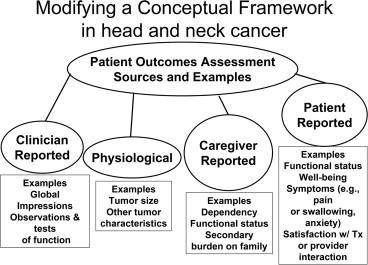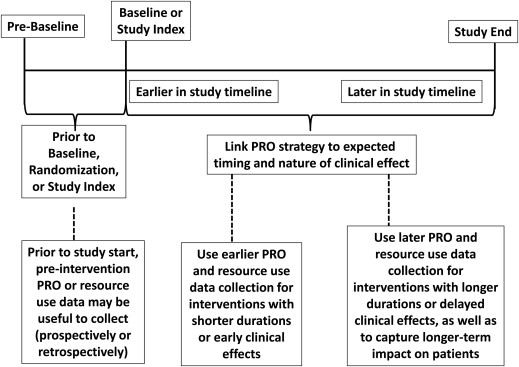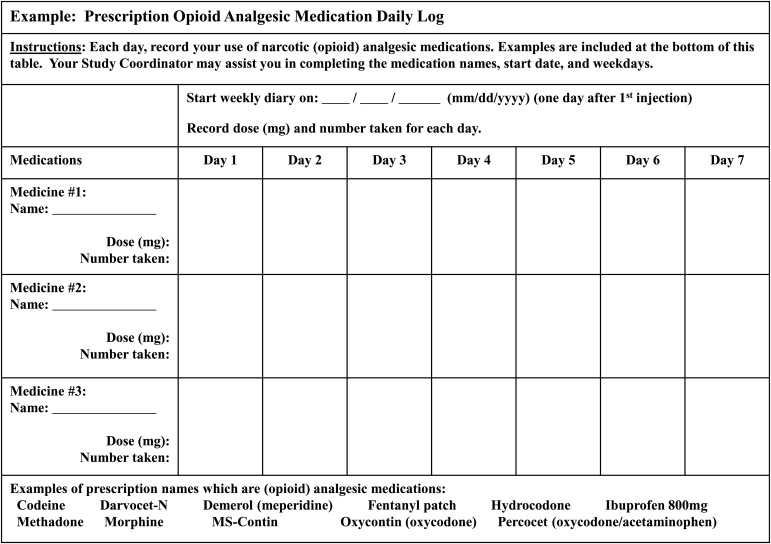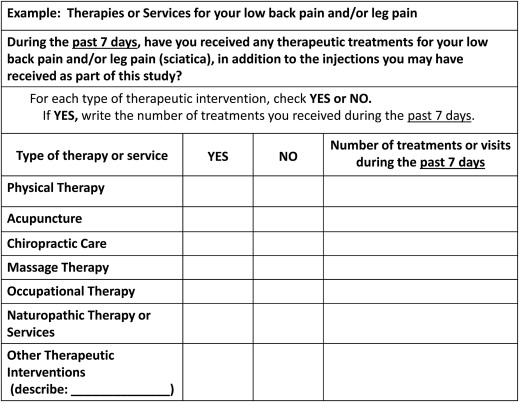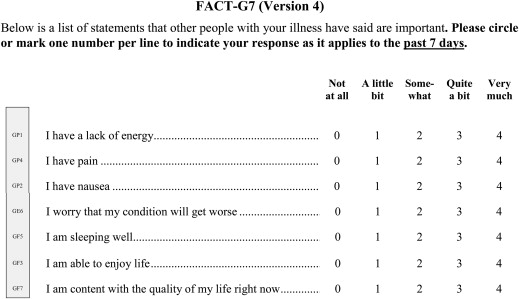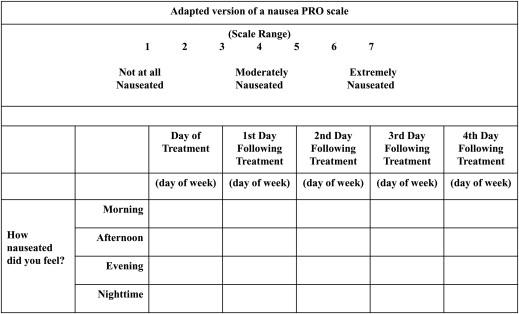Rationale
More efficient and better informed healthcare systems are expected to have improved knowledge of the impact of interventions on patient outcomes and resources used by patients and providers in specific health conditions.
Objectives
To describe trends related to putting patients at the center of healthcare decision making, regulatory trends and best practice recommendations for developing high-quality patient-reported outcomes (PROs), and strategic issues related to including PROs in studies.
Materials and Methods
We summarize PRO concepts, definitions, and broadly-accepted scientific standards for developing, assessing, and interpreting PROs. Three conceptual models are presented as examples for assessing PROs in relation to other outcomes. We discuss different perspectives for stakeholders, including regulatory issues pertaining to formal guidance for PRO development and for use in trials. We provide examples of PROs used in studies for assessing health outcomes in oncology and resource-use outcomes in low back pain patients.
Results
Psychometric scientists working closely with multi-disciplinary teams and regulatory authorities have greatly improved the science of collecting, assessing, and understanding patient-reported outcomes in clinical trials. A simplified framework is presented for strategic considerations for including PROs in studies, such as the appropriate timing for PRO endpoints. Asking patients about their health status and/or use of resources improves our understanding of how interventions and care processes may impact their lives and their budgets. We provide examples from a back pain trial of patient-reported resource-use questionnaires for medicines taken and other services or products used by patients.
Conclusions
Healthcare stakeholders are placing increased emphasis on resource use and the impact of interventions on patients, including effects associated with diagnostic tests. Patient-reported outcomes are being used in clinical practice and in clinical research, supported by formal best-practice guidelines. Radiology has a role as an engaged stakeholder in the design, conduct, and interpretation of patient-based evidence, and in its relevance to health policy implementation.
Patient-reported outcomes (PROs) provide valuable health information. Patients, providers, and health systems are being encouraged and incentivized to involve patients and their families more directly in health care decision making. Examples of support for additional evidence development related to patient outcomes in the United States include the creation of the Patient-Centered Outcomes Research Institute (PCORI) , published priorities in comparative effectiveness research (CER) , and the Agency for Healthcare Research and Quality’s (AHRQ’s) emphasis on patient-centered outcome research . “Patient-centered outcomes research (PCOR) helps people and their caregivers communicate and make informed health care decisions, allowing their voices to be heard in assessing the value of health care options” . Patient input is being sought in developing research priorities, informing shared decision-making models, selecting meaningful outcomes for clinical research, and disseminating information to patients and providers. Consequently, PROs and other relevant patient-reported data have become more ingrained in clinical research, observational research, clinical care, and quality improvement initiatives.
Get Radiology Tree app to read full this article<
Get Radiology Tree app to read full this article<
Scientific standards for PROs
General Guidance on Including Patient-Based Outcomes in Studies
Get Radiology Tree app to read full this article<
Get Radiology Tree app to read full this article<
Get Radiology Tree app to read full this article<
Get Radiology Tree app to read full this article<
Get Radiology Tree app to read full this article<
Definitions and Desired Properties of PROs
Get Radiology Tree app to read full this article<
Get Radiology Tree app to read full this article<
Get Radiology Tree app to read full this article<
Conceptual Models Providing Context for PROs
Get Radiology Tree app to read full this article<
Get Radiology Tree app to read full this article<
Get Radiology Tree app to read full this article<
Get Radiology Tree app to read full this article<
Multidisciplinary Study Teams
Get Radiology Tree app to read full this article<
Regulatory and Research Guidance for Including PROs in Trials
Get Radiology Tree app to read full this article<
Resource-Use questionnaires completed by patients
Get Radiology Tree app to read full this article<
Get Radiology Tree app to read full this article<
Get Radiology Tree app to read full this article<
Strategic development of patient-reported evidence
Considering PRO Impact Early in Product Life Cycles for Medicines and Procedures
Get Radiology Tree app to read full this article<
Get Radiology Tree app to read full this article<
Get Radiology Tree app to read full this article<
Timing of PRO Inclusion in Studies
Get Radiology Tree app to read full this article<
Get Radiology Tree app to read full this article<
Get Radiology Tree app to read full this article<
Get Radiology Tree app to read full this article<
Additional Practical Issues Related to Including PROs in Trials
Get Radiology Tree app to read full this article<
Get Radiology Tree app to read full this article<
Get Radiology Tree app to read full this article<
Examples From Clinical Studies
Get Radiology Tree app to read full this article<
Get Radiology Tree app to read full this article<
Get Radiology Tree app to read full this article<
Get Radiology Tree app to read full this article<
Get Radiology Tree app to read full this article<
Get Radiology Tree app to read full this article<
Conclusions
Get Radiology Tree app to read full this article<
Get Radiology Tree app to read full this article<
Get Radiology Tree app to read full this article<
Get Radiology Tree app to read full this article<
Get Radiology Tree app to read full this article<
Acknowledgments
Get Radiology Tree app to read full this article<
Get Radiology Tree app to read full this article<
Get Radiology Tree app to read full this article<
References
1. http://www.pcori.org (accessed March 17, 2014).
2. Institute of Medicine, http://www.nap.edu/openbook.php?record_id=12648 (accessed March 21, 2014).
3. Inglehart J.K.: Prioritizing comparative-effectiveness research—IOM recommendations. NEJM 2009; 361: pp. 325-328.
4. Pandharipande P.V., Gazelle G.S.: Comparative effectiveness research: what it means for radiology. Radiology 2009; 253: pp. 600-605.
5. http://www.ahrq.gov/ (accessed March 17, 2014).
6. Chassany O., Sagnier P., Marquis P., et. al.: Patient-reported outcomes: the example of health-related quality of life—a European guidance document for the improved integration of health-related quality of life assessment in the drug regulation process. DIJ 2002; 36: pp. 209-238.
7. http://www.ema.europa.eu/docs/en_GB/document_library/Scientific_guideline/2009/09/WC500003637.pdf (accesses March 12, 2014).
8. United States Health and Human Services, Food and Drug Administration, guidance for industry, patient-reported outcome measures: use in medical product development to support labeling claims, December 2009. ( http://www.fda.gov/MedicalDevices/DeviceRegulationandGuidance/GuidanceDocuments/default.htm , accessed March 12, 2014).
9. Spilker BertCramer JoyceQuality of life & pharmacoeconomics: an introduction.1998.Lippincott-RavenPhiladelphia:
10. McDowell I., Newell C.: Measuring health: a guide to rating scales and questionnaires.1996.Oxford PressNew York
11. http://www.fda.gov/Drugs/DevelopmentApprovalProcess/DrugDevelopmentToolsQualificationProgram/ucm284077.htm (accessed March 18, 2014).
12. http://phi.uhce.ox.ac.uk/home.php , (accessed March 17, 2014).
13. Revicki D.A., Gnanasakthy A., Weinfurt K.: Documenting the rationale and psychometric characteristics of patient reported outcomes for labeling and promotional claims: the PRO Evidence Dossier. Qual Life Res 2007; 16: pp. 717-723.
14. Patrick D.L., Burke L.B., Gwaltney C.J., et. al.: Content validity—Establishing and reporting the evidence in newly-developed patient-reported outcomes (PRO) instruments for medical product evaluation: ISPOR PRO good research practices task force report: Part 1-Eliciting concepts for a new PRO instrument. Value Health 2011; 14: pp. 967-977. [Epub October 13, 2011]
15. Patrick D.L., Burke L.B., Gwaltney C.J., et. al.: Content validity—Establishing and reporting the evidence in newly-developed patient-reported outcomes (PRO) instruments for medical product evaluation: ISPOR PRO good research practices task force report: Part 2 – assessing respondent understanding. Value Health 2011; 14: pp. 978-988. [Epub October 13, 2011]
16. http://www.nihpromis.org/about/overview (accessed March 13, 2014).
17. http://www.assessmentcenter.net/documents/InstrumentLibrary.pdf , accessed March 21, 2014).
18. Gold MR, Siegel JE, Russell LB, et al. Cost-effectiveness in health and medicine. 1996.
19. Ramsey S., Willke R., Briggs A., et. al.: Good research practices for cost-effectiveness analysis alongside clinical trials: the ISPOR RCT-CEA Task Force report. Value in Health 2005; 8: pp. 521-533.
20. Neumann P.J.: Using cost-effectiveness analysis to improve health care: opportunities and barriers.2004.Oxford University PressOxford
21. Drummond M.F., O’Brien B., Stoddart G.L., et. al.: Methods for the economic evaluation of health care programmes.3rd ed.2005.Oxford University PressOxford
22. Wilson I.B., Cleary B.D.: Linking clinical variables with health-related quality of life. A conceptual model of patient outcomes. JAMA 1995; 273: pp. 59-65.
23. http://www.who.int/classifications/icf/en/ ; accessed on March 14, 2014.
24. Calvert M., Brundage M., Jacobsen P.B., et. al.: The CONSORT patient-reported outcome (PRO) extension: implications for clinical trials and practice. Health and Quality of Life Outcomes 2013; 11: pp. 184-190.
25. Gondek K., Sagnier P.P., Gilchrist K., et. al.: Current status of patient-reported outcomes in industry-sponsored oncology clinical trials and product labels. J Clin Oncol 2007; 25: pp. 5087-5093.
26. Garrison L.P., Bauch C.T., Bresnahan B.W., et. al.: Using cost-effectiveness analysis to support R&D portfolio prioritization for product innovations in measles vaccination. J Infectious Diseases 2011; 204: pp. S124-S132.
27. Hollingworth W., Jarvik J.G.: Technology assessment in radiology: putting the evidence in evidence-based radiology. Radiology 2007; 244: pp. 31-38.
28. Smeets R., Koke A., Lin C.-W., et. al.: Measures of function in low back pain/disorders: Low Back Pain Rating Scale (LBPRS), Oswestry Disability Index (ODI), Progressive Isoinertial Lifting Evaluation (PILE), Quebec Back Pain Disability Scale (QBPDS), and Roland-Morris Disability Questionnaire (RDQ). Arthritis Care & Research 2011 Nov; 63: pp. S158-S173.
29. Roland M., Morris R.: A study of the natural history of back pain. Part I: development of a reliable and sensitive measure of disability in low-back pain. Spine (Phila Pa 1976) 1983; 8: pp. 141-144.
30. Roland M., Fairbank J.: The Roland-Morris Disability Questionnaire and the Oswestry Disability Questionnaire. Spine (Phila Pa 1976) 2000; 25: pp. 3115-3124.
31. Fairbank J.C., Couper J., Davies J.B., et. al.: The Oswestry Low Back Pain Disability Questionnaire. Physiotherapy 1980; 66: pp. 271-273.
32. Graves J.M., Fulton-Kehoe D., Jarvik J.G., et. al.: Early imaging for acute low back pain one-year health and disability outcomes among Washington State workers. Spine 2012; 37: pp. 1617-1627.
33. Friedly J.L., Bresnahan B.W., Comstock B., et. al.: Study protocol–Lumbar Epidural Steroid Injections for Spinal Stenosis (LESS): a double-blind randomized controlled trial of epidural steroid injections for lumbar spinal stenosis among older adults. BioMed Central Musculoskeletal Disorders 2012; 13: pp. 48.
34. Sloan J.A., Berk L., Roscoe J., et. al.: Integrating patient-reported outcomes into cancer symptom management clinical trials supported by the National Cancer Institute–sponsored clinical trials networks. J Clin Oncol 2007; 25: pp. 5070-5077.
35. Brunner D.W., Bryan C.J., Aaronson N., et. al.: Issues and challenges with integrating patient-reported outcomes in clinical trials supported by the National Cancer Institute–sponsored clinical trials networks. J Clin Oncol 2007; 25: pp. 5051-5057.
36. Minasian L.M., O’Mara A.M., Reeve B.B., et. al.: Health-related quality of life and symptom management research sponsored by the National Cancer Institute. J Clin Oncol 2007; 25: pp. 5128-5132.
37. Osoba D.: Health-related quality of life and cancer clinical trials. Therapeutic Advances in Medical Oncology 2011; 3: pp. 57-71.
38. Billingham L.J., Abrams K.R., Jones D.R.: Methods for the analysis of quality-of-life and survival data in health technology assessment. Health Technol Assess 1999; 3:
39. Center for Medical Technology Policy, Recommendations for incorporating patient-reported outcomes (PROs) into clinical comparative effectiveness research (CER) in adult oncology, effectiveness guidance document, Published Version 1.0, May 20, 2012. ( http://www.cmtpnet.org/resource-center/view/egd-on-patient-reported-outcomes-in-cer-and-adult-oncology/ ; accessed March 17, 2014).
40. Yanez B., Pearman T., Lis C.G., et. al.: The FACT-G7: a rapid version of the functional assessment of cancer therapy-general (FACT-G) for monitoring symptoms and concerns in oncology practice and research. Annals of Oncology 2013; 24: pp. 1073-1078.
41. http://www.facit.org/FACITOrg/Questionnaires (accessed March 21, 2014).
42. Carlos R., Buist D.S., Wernli K.J., et. al.: Patient centered outcomes in imaging: quantifying value. JACR 2012; 9: pp. 725-728.
